KEY TAKEAWAYS
- The study aimed to examine patients’ RRTW after head and neck tumor treatment and analyze related factors.
- The results revealed the importance of children’s status, education, self-efficacy, illness uncertainty, and psychosocial adjustment in RRTW.
Liying Wen and the team aimed to investigate the readiness for return-to-work (RRTW) among patients with head and neck cancer (HNC) and analyze the relationships between self-efficacy, disease uncertainty, psychosocial adaptation, and RRTW in patients with HNC.
The study involved 259 patients with HNC who were discharged for at least 1 month. Research tools included a self-designed general information questionnaire, the RRTW Scale, the General Self-Efficacy Scale (GSES), the Mishel Uncertainty in Illness Scale (MUIS), and the Self-Reporting Psychosocial Adjustment to Illness Scale (PAIS-SR).
Statistical analyses included descriptive analysis, the rank sum test, Spearman correlation analysis, and ordered multiple and dichotomous logistic regression analyses.
The results revealed that the overall readiness for RRTW among patients with HNC was low, at 41.9%. Those who did not return to work were primarily in the precontemplation stage (38.1%) and contemplation stage (29.9%), while those who did return were mainly in the active maintenance stage (64.2%).
Factors influencing RRTW among patients with HNC who had not returned to work included children’s status (OR = 0.218, 95% CI 0.068-0.703), self-efficacy (OR = 1.213, 95% CI 1.012-1.454), unpredictability (OR = 0.845, 95% CI 0.720-0.990), occupational environment (OR = 0.787, 95% CI 0.625-0.990), and family environment (OR = 0.798, 95% CI 0.643-0.990).
Educational level (OR = 62.196, 95% CI 63.307-68.567), children’s status (OR = 0.058, 95% CI 1.004-2.547), self-efficacy (OR = 1.544, 95% CI 3.010-8.715), unpredictability (OR = 0.445, 95% CI 1.271-2.280), and psychological status (OR = 0.340, 95% CI 1.141-2.401) influenced the RRTW of patients with HNC who had returned to work.
The study concluded that factors such as children’s status, education level, self-efficacy, illness uncertainty, and psychosocial adjustment play vital roles in facilitating RRTW among patients. These findings offered a theoretical foundation for developing intervention strategies to enhance RRTW outcomes.
No funding information was available.
Source: https://pubmed.ncbi.nlm.nih.gov/38850487/
Wen, L., Gao, Z., Zhong, X. et al. (2024). “Readiness for return to work and its influencing factors among head and neck cancer patients: a cross-sectional study.” Support Care Cancer 32, 420 (2024). https://doi.org/10.1007/s00520-024-08622-z.



